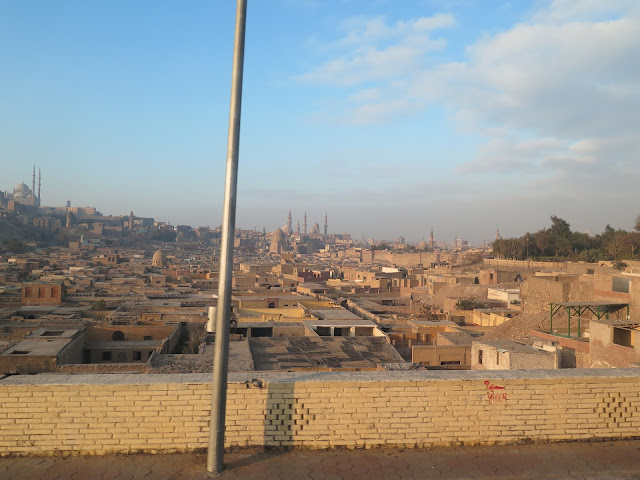We are headed now to Memphis which was once one of the oldest and most important cities of ancient Egypt. Memphis is located at the entrance to the Nile River Valley and was a once the capital of Egypt. It was also the principal port and centre for commerce, trade and religion. Memphis had many factories and warehouses which distributed food throughout the ancient kingdom. Pharaohs such as Menes and Ramses II reigned in Memphis.
Many of my photos were taken looking out from a bus window so they aren't the best but this shows how densely populated Cairo is. People live among broken down buildings and rubble.

Wherever there is a tourist site, there will always be many vendors selling replicas of statues, pyramids and hand made items.

Upon entrance to the museum, Courtney was met by this Egyptian. He said, "Come, take a photo" after which he wanted to be paid $1. We learned very quickly that unless we were prepared to pay for photos, we should ignore their requests because they will follow you around and not leave you alone.
We are looking at the statue of Ramses II in Memphis in the museum. It was discovered in 1820 at the Great Temple of Ptah near Memphis (Egypt) and was broken into 6 pieces. It is made of red granite, weighs 83 tons and is 36' in length. Seeing such a large statue raised many questions: how they were carved and how were they transported to intended locations?
This statue represents a king in traditional pharaonic pose. He is sitting on a throne with his hands flat on his thighs, wearing a headdress with a cobra and a false beard. The names and titles of Ramses II are inscribed on the belt buckle, and on the back and sides of the throne. If Ramses II was the pharaoh of the Exodus, Moses most certainly spent time in Memphis.


The statues seemed relatively small until someone stood next to them.

Travis is such a fun student and always brings a smile.

"Come on, Sister Holyoak, we'll boost you up," laughed Aaron. I said, "I hope I don't break your back."
Garth and I really enjoy our association with the students and they treat us like family.
Garth and I really enjoy our association with the students and they treat us like family.
"Monkey see . . . Monkey do!"
Maya stands at the back of a statue. Notice the Hieroglyphics carved in the stone.
Below is a chart of the ancient hieroglyphics.
We are headed now to a papyrus factory. Our security guards are still on duty.
Long before paper came into existence, the Egyptians created a version of paper made from the pith of the papyrus plant. We visited a factory and were fascinated by the beautiful artwork on display.
 |
| Photo from the Internet |
This young artist demonstrated the process of making papyrus paper.
It was very interesting to watch as she explained each step.
The first step is to select a stalk the length of the paper you want to make
because the paper is made from the stem of the plant.
When the stem is cut, the end of the stalk has a triangular shape. This will eventually become more flat once the outer layers are peeled off and the inner shaft or pith is exposed. The inner shaft is fibrous and sticky and is then cut lengthwise into very thin strips.
Each strip (or pith) is pounded, rolled thin with a rolling pin and then placed in water to soak until they rot slightly. This makes them sticky so they can be pieced together easier.
The strips are then placed side by side on a hard surface with their edges slightly overlapping. Another layer of strips is then laid on top at a right angle. While still moist, the two layers are hammered together, mashing the layers into a single sheet.
The paper is then put in a press where is left to dry flat. The whole process takes about one week to make one sheet. In a dry climate like that of Egypt, papyrus paper will last because it is rot-resistant.
The young Egyptian held the paper up to the light so we could
see how the strips were layered.
She also demonstrated that the paper is extremely durable and won't tear.
Ancient documents were written on sheets of papyrus joined together side by side and rolled up into a scroll with a stick at the end. This was the earliest form of a book. The Dead Sea Scrolls were also written on papyrus and now we have a much better understanding how the paper was made.
This Tree of Life was beautiful. Most papyrus artworks are displayed behind glass (without frames) because the uneven edges of the papyrus add interest and look nicer than covered by frames.
We were on a tight schedule and so were off now to the next site. Everything I have posted in this post and the previous one, were part our first day in Egypt and I haven't yet shared our visit to Giza Pyramids which really amazing so the best is yet to come!
To be continued . . .





























This is so fascinating. Can't wait for each installment :)
ReplyDelete